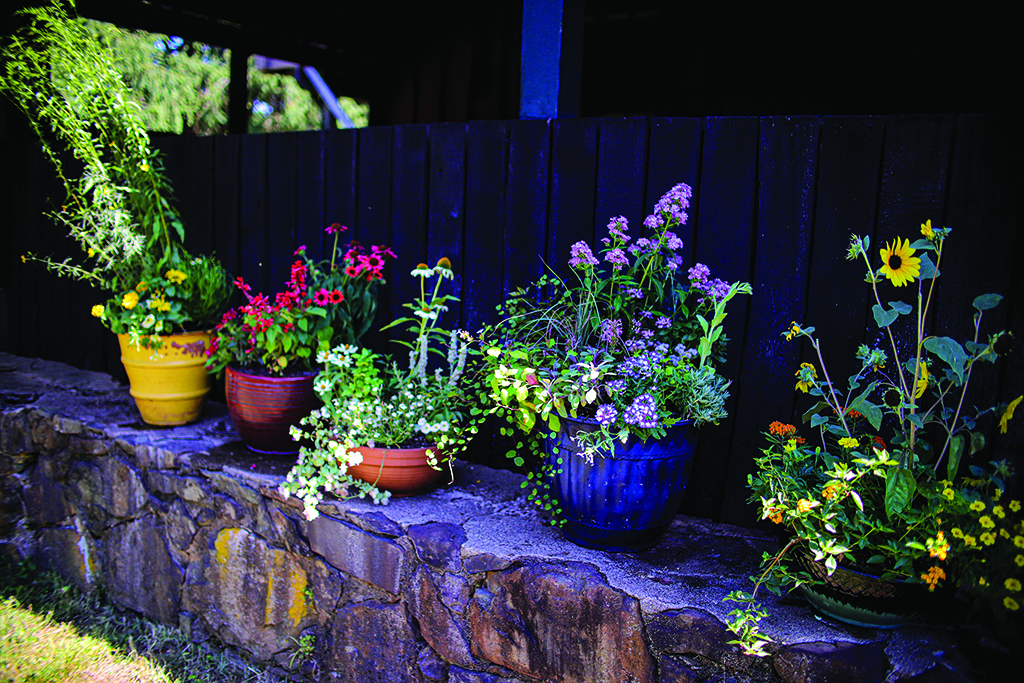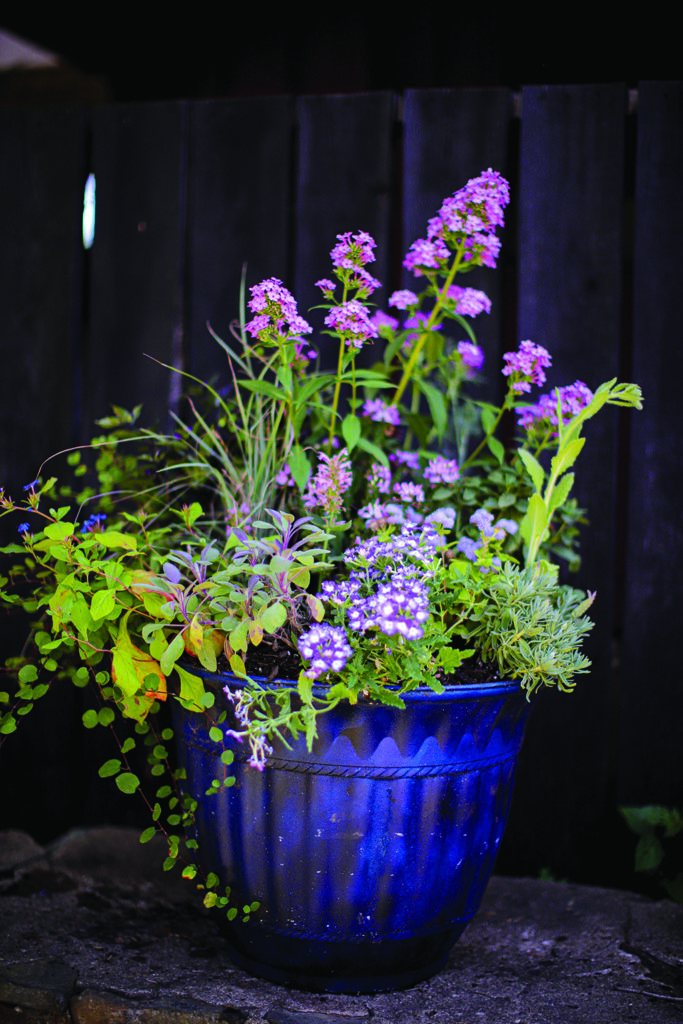Create Your Own Patio Pollinator Garden

With Five Color Themes that Attract Different Pollinators
Written by Patrick Mulrooney | ISA Certified Arborist MA-5036
Photos by Jennifer Gray
It is too hot to go outside. We should probably do our garden viewing from the inside, under the safety of air conditioning and with the aid of a huge window.
That’s what I was thinking recently when I decided to make some colorful potted plant arrangements for my patio. My challenge? To find, out of all the showy flowers and hybrid cultivars that I can buy at the store, the ones that actually produce resources for pollinators. After some serious research and weeks of personal observation, I ended up with a sizable list of native and non-native annuals that are good nectar producers, as well as some powerhouse perennials to add to the mix.
Finding a theme for the first pot was easy — hummingbirds (aka RED). For the centerpiece, I chose a red coneflower (Echinacaea purpurea, “Sombrero Tres Amigos”). The shiny green and blue sweat bees (Agapostemon, Augochloropsis, and Halictidae) loved this plant. While buying a perennial might seem like a waste of money for a seasonal display, think about transplanting it to the garden in the fall.

Around the coneflower, I used two types of red sage (Salvia splendens), multitudes of pentas, a red nicotiana, and a very “loud” firecracker cuphea (Cuphea purpurea). Drooping off the sides are two fuchsias. All the usual visitors loved the nectar, but the moth-friendly nicotiana attracts the strange hummingbird moth, which is as interesting as the name suggests.
It was at this point I remembered bees cannot see the color red. To make sure they felt included, the next planter would have a blue theme. According to scientists, blues are the most likely colors to attract bees. The centerpiece was again a perennial — Phlox paniculate “jeana,” which I should be able to transplant into the garden come fall as it claims to be immune to powdery mildew.
The rest of the plant choices were equally strong — native annuals such as agastache and ageratum as well as non-natives like cleome, hardy plumbago (Ceratostigma plumbagnoides), borage (Borago officinalis),
verbena, and a purple flash ornamental pepper for background.
Due to their consistent nectar production, herbs are always a welcome plant for the pollinators. Fortunately, there were several with blue tones that went well with the composition. I was thrilled to find a dwarf lavender, and then added some dill and common sage, that I will let go to flower immediately. Little bluestem perennial grass, while not flashy, fits the blue theme and feeds several caterpillars in the skipper butterfly family as well as songbirds which eat the seeds.
So many yellow flowers are in bloom right now that I had to build two planters to represent this color. To cater to the birds, I chose an annual sunflower (Helianthus anuus) as the centerpiece of the first one. Shiny little sweat bees love it now, and the seeds will be a great food source for songbirds later on. For the second yellow-themed planter, I chose a native goldenrod (Solidago sp.) for the center. This plant’s prodigious nectar production lasts four to six weeks and can greatly increase a bee colony’s winter survival. No doubt it will be making it into my garden at the end of the season.
Surrounding the centerpieces are mixes of orange and yellow perennials and annuals. Perennial milkweed (Asclepias tuberosa) provides nectar and is a larval host for monarch and grey hairstreak butterflies. Perennial coreopsis “sweet marmalade,” and the regular, taller coreopsis provide nectar and pollen. Other dependable nectar plants are lantana, zinnia, calibrachoa, and petunias, for a trailing effect. I added marigolds as well due to their ability to repel pests and promote good vegetable growth for my nearby tomatoes and Brussels sprouts.

Herbs can provide understated beauty in a planter, even with few other flowers. Again, I chose echinacea for the centerpiece, this time in white. Spearmint, thyme, rosemary, and peppers surround it and white lobelia, zinnia, and Salvia farinacea provide the color. In my opinion, the most interesting plant I came across was the ornamental oregano (Origanum rotundifolium), which makes a sweetly elegant trailer and an even better nectar source.
I recommend this project. It was a lot of fun. In the midst of COVID-19, gardening is helping us stay active and engaged as we are more confined to our homes. Practically, it feeds and attracts the pollinators that help produce our vegetables and balance our ecosystem. Aesthetically, it is enjoyable and calming to create and to look at. There might also be an additional box to check as scientists warn about worldwide insect decline. Recently, I heard about the “windshield phenomenon,” the observation that dead insects no longer accumulate on the windshields of people’s cars after a long drive, and it affected me much more than any grim statistic could.
But let’s not end on a somber note! The fact that you are reading this means people are paying attention to the wonders of the garden and the many gifts a thoughtful gardener can make available to our pollinators. The return on that investment is priceless. ML
This article was first published in the August 2020 issue of Middleburg Life.





